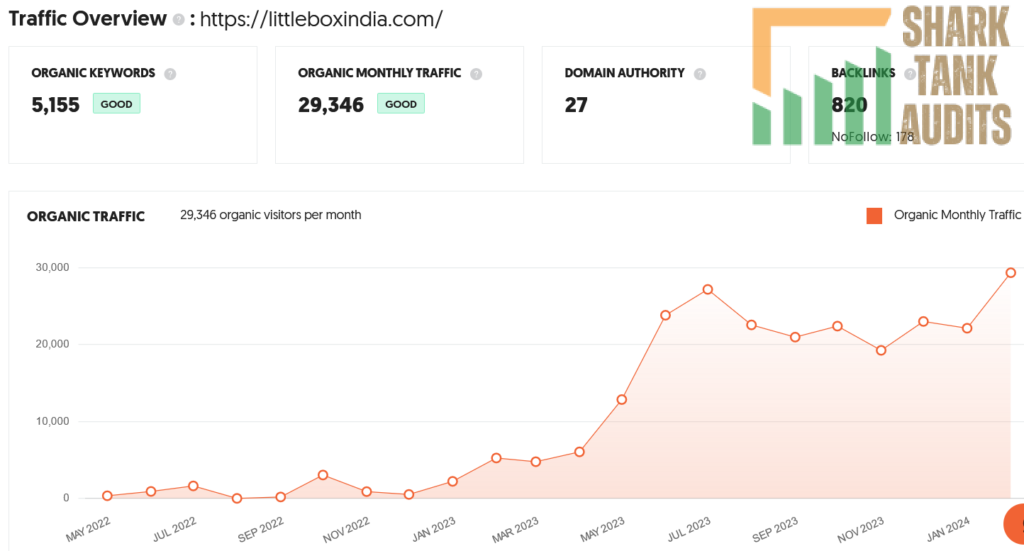Littlebox Shark Tank India Episode Review
Website Information:
- Website:- Littlebox
- Build on E-commerce Shopify
- Advertise with Microsoft Advertising and Google Ads
- Boost with SEO
- ORGANIC TRAFFIC:- 29,346 organic visitors per month
Founders and Story:
- Partha Kakati and Rimjim Deka launched LittleBox, a Gen Z-focused fast-fashion brand, in June 2022.
- The company boasts over 2 lakh shipped orders and a strong daily shipment average of over 1200.
- Headquartered in Guwahati with factories and warehouses in Delhi, LittleBox leverages the founders’ prior experience in the D2C apparel space (established in 2012).

Products and Operations:
- LittleBox offers a curated selection of clothing and footwear, catering to diverse styles like edgy, elegant, cute, and sexy.
- Popular items include two-piece sets, corsets, skirts, and men’s knit shirts.
- They primarily operate through their website and a large Instagram following (1.75 lakh).
- To minimize deadstock, they involve customers in the design process and produce popular styles in small batches (30 units).
- With an average order value of Rs 1250, they boast a 22% repeat rate, a 7% exchange rate, and a 20-21% return rate.
- Strong organic daily orders (120) reflect consistent demand.
Company Mission and Vision:
- LittleBox prioritizes exceeding customer expectations with high-quality products and a seamless shopping experience.
- They currently focus on streetwear, aiming to be a trendsetting destination for instant, celebrity-inspired looks.
- This Northeast Indian brand aims to establish itself globally with its unique blend of affordability and sustainable design.
- Founded on inclusivity and sustainability, LittleBox has seen rapid growth driven by customer trust, price sensitivity, and commitment to zero-waste practices.
Financials (as of August 2023):
- Sales: Rs 2 crore
- Projected FY 2023-2024 Net Sales: Rs 36 crore
- FY 2023-2024 (September) EBITDA: 15%
Shark Tank India Episode AIR Date:
- Episode 35, 8 March 2024
Shark Tank India Pitch:
- Founders requested Rs 75 lakh for 1% equity at a valuation of Rs 75 crore.
- Sharks offered various deals, with the final agreement being:
- Rs 75 lakh for 2.5% equity at a valuation of Rs 30 crore (all Sharks)
Key Takeaways:
- LittleBox is a promising Gen Z fashion brand with a strong initial performance.
- The founders secured a significant investment in Shark Tank India, showcasing investor confidence in their growth potential.

Littlebox Shark Tank India Review Website Data
| Aspect | Description | Data/Stat |
|---|---|---|
| Website | LittleBox | – |
| Platform | Shopify | – |
| Marketing | ||
| * Organic Traffic | 29,346 visitors per month | |
| Business Potential | ||
| * TAM (Estimated) | Indian Apparel Market | ₹500 billion (USD 6.6 billion) |
| Target Audience | ||
| * Demographics | Age 18-25, Tier 1, 2 & 3 cities, India | – |
| * Psychographics | Tech-savvy, fashion-conscious, value affordability, influenced by social media trends | – |
| Marketing Strategy | Content Marketing & Digital Marketing | |
| * Content Marketing | – Create engaging content showcasing styles, sustainability efforts, and Gen Z fashion inspiration. – Partner with micro-influencers for reviews and trendsetting content. | – |
| * Digital Marketing | – SEO Optimization – Social Media Marketing (Instagram, TikTok, Snapchat) – Email Marketing with personalized recommendations | – |
| Distribution Strategy | Omnichannel | |
| * E-commerce Expansion | Maintain presence on existing platforms (Myntra, Ajio, Flipkart) | – |
| * Omnichannel Strategy | Explore partnerships with select physical stores | – |
| Advantages | ||
| * Product Offering | High-quality, trendy clothing and footwear catering to diverse styles | – |
| * Focus on Sustainability | Appeals to environmentally conscious Gen Z consumers | – |
| * Direct-to-Consumer Model | Enables control over brand image and pricing (average order value of Rs 1250) | – |
| * Experienced Founders | Prior success in the D2C apparel space ensures strategic direction | – |
| Challenges | ||
| * High Competition | The fast-fashion market is crowded | – |
| * Brand Awareness | Needs to expand reach beyond current organic traffic | – |
| * Profitability | Needs improvement to maintain healthy margins (15% EBITDA) | – |
| Reasons for Success | ||
| * Catering to a Growing Market | Addresses the demand for trendy and affordable fashion among Gen Z | – |
| * Unique Value Proposition | Combines affordability with sustainability | – |
| * Strong Online Presence | Leverages digital marketing to reach the target audience | – |
| * Data-Driven Approach | Utilizes customer data and website analytics for optimization | – |
| Mitigation Strategies | ||
| * Product Line Innovation | Continuously research and develop new, on-trend designs | – |
| * Omnichannel Marketing | Expand brand presence across various online and offline channels | – |
| * Data & Analytics Focus | Utilize data to understand customer behavior and improve offerings | – |
| * Cost Optimization | Negotiate with suppliers and streamline production processes | – |
| Future Business Roadmap | ||
| * Increase Valuation | Focus on brand awareness, strategic expansion, and improved profitability | Secured Rs 75 lakh for 2.5% equity at a valuation of Rs 30 crore on Shark Tank India |
| * Product Line Expansion | Consider introducing new categories like athleisure or activewear | – |
| * Technology Investment | Implement CRM system for personalized customer experiences | – |
| * Social Responsibility | Partner with NGOs promoting environmental sustainability or youth empowerment initiatives | – |
LittleBox: Building a Thriving Gen Z Fashion Brand

Business Potential in India:
- Rising Fashion Consciousness: A growing young population with rising disposable income is driving a surge in fashion spending in India. (Source: IBEF)
- Shift towards Online Shopping: E-commerce in India is booming, with the fashion sector witnessing significant growth. (Source: Statista)
- Fast Fashion Popularity: Gen Z consumers favor trendy, affordable clothing, making fast fashion a relevant market segment. (Source: McKinsey & Company)
Total Addressable Market (TAM):
- The Indian apparel market is expected to reach ₹3.3 trillion (USD 43.3 billion) by 2024. (Source: TechSci Research)
- Considering LittleBox’s focus on Gen Z and fast fashion, a conservative TAM estimate could be ₹500 billion (USD 6.6 billion).
Ideal Target Audience:
- Demographics: Age 18-25, Tier 1, 2 & 3 cities, India
- Psychographics: Tech-savvy, fashion-conscious, value affordability, influenced by social media trends
Marketing Strategy:
Content Marketing:
- Create engaging blog posts and social media content showcasing LittleBox’s unique styles, sustainability efforts, and Gen Z fashion inspiration. (29,346 organic visitors per month is a good starting point to leverage)
- Partner with micro-influencers popular with the target audience for product reviews and trendsetting content.
Digital Marketing Strategy:
- SEO Optimization: Increase website ranking through keyword research, content optimization, and backlink building to capture organic traffic.
- Social Media Marketing: Build a strong presence on Instagram, TikTok, and Snapchat with visually appealing content and targeted ad campaigns.
- Email Marketing: Build an email list and send engaging newsletters featuring new arrivals, promotions, and styling tips. Offer personalized recommendations based on past purchases (average order value of Rs 1250 indicates a potential customer base).
Distribution Strategy:
- E-commerce Expansion: Maintain a strong presence on existing platforms like Myntra, Ajio, and Flipkart.
- Omnichannel Strategy: Explore partnerships with select physical stores to offer a touch-and-feel experience (strong potential considering 22% repeat rate).
Advantages:
- Strong Product Offering: High-quality, trendy clothing and footwear catering to diverse styles.
- Focus on Sustainability: Appeals to environmentally conscious Gen Z consumers.
- Direct-to-Consumer Model: Enables control over brand image and pricing (average order value of Rs 1250 indicates a healthy margin).
- Experienced Founders: Prior success in the D2C apparel space ensures strategic direction.
Challenges:
- High Competition: The fast-fashion market is crowded with established players and new entrants.
- Brand Awareness: LittleBox needs to expand its reach beyond its current organic traffic (29,346 visitors per month).
- Profitability: Maintaining a healthy profit margin while offering competitive prices requires efficient production and inventory management (15% EBITDA is a good starting point but needs improvement).
Reasons for Success:
- Catering to a Growing Market: Addressing the demand for trendy and affordable fashion among Gen Z.
- Unique Value Proposition: Combining affordability with sustainability resonates with environmentally conscious consumers.
- Strong Online Presence: Leveraging digital marketing to reach the target audience effectively.
- Data-Driven Approach: Utilizing customer data and website analytics to optimize marketing efforts and product development.
Mitigation Strategies:
- Product Line Innovation: Continuously research and develop new, on-trend designs based on customer feedback and market research.
- Omnichannel Marketing: Expand brand presence across various online and offline channels to reach a wider audience.
- Data & Analytics Focus: Utilize data to understand customer behavior, optimize marketing spend, and improve product offerings.
- Cost Optimization: Negotiate with suppliers and streamline production processes to maintain healthy margins (15% EBITDA is a starting point).
Future Business Roadmap:
- Increase Valuation: Focus on brand awareness, strategic expansion, and improved profitability to demonstrate a clear path to growth for potential investors (founders secured Rs 75 lakh for 2.5% equity at a valuation of Rs 30 crore on Shark Tank India, showcasing investor confidence).
- Product Line Expansion: Consider introducing new categories like athleisure or activewear based on market trends and customer demand.
- Technology Investment: Implement a Customer Relationship Management (CRM) system for personalized customer experiences.
- Explore AI Integration: Utilize artificial intelligence for product recommendations and chatbots to enhance customer service.
- Social Responsibility: Partner with NGOs promoting environmental sustainability or youth empowerment initiatives to solidify LittleBox’s commitment to social good.
By implementing this comprehensive plan, LittleBox can solidify its position as a leading Gen Z fashion brand.
Conclusion:
LittleBox has a strong foundation for success in the booming Indian fashion market. By leveraging its unique blend of affordability, sustainability, and trendy styles, coupled with a data-driven marketing approach and strategic expansion plans, LittleBox can become a leading Gen Z fashion brand. The successful Shark Tank India pitch (Rs 75 lakh for 2.5% equity at a valuation of Rs 30 crore) validates investor confidence in the brand’s potential. By overcoming challenges and continuously innovating, LittleBox can achieve significant growth and establish itself as a major player in the Indian fashion landscape.



